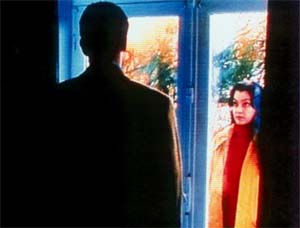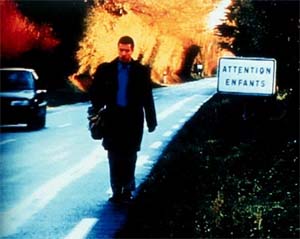
|
In Praise of Love is not easy to comprehend (though it is deeply pleasurable - thrilling! - to engage). This bit of narration provides access to understanding the film's ecstatic cinematics. Every sound-image collage should be read with this poetically phrased, yet philosophically-grounded dialectic in mind. In Praise of Love is an ode to memory, the recording of memories (history), and the emotions resonating through that history ("the image of a loved one"). This means that the spectator must constantly reflect upon (and back on) the movie's sound-images. For sheer awe, no other living filmmaker bests Godard's sublime technique. His compositional tactility is such that the image of piano - sans piano player - makes music. The narrative structure of In Praise of Love heightens the sound-image intensity. The first half of In Praise of Love takes place in the present, when a filmmaker named Edgar (Bruno Putzulu) seeks and finds a woman, named Elle (Cecile Camp), whom he met two years prior and whom he intends to cast in his movie about the four stages of love. The male character in Edgar's film will be named Perceval, and Edgar's quest is similar to the mythic Perceval's quest for an ideal. This first half is filmed - beautifully! - using black-and-white film stock, the medium for investigating physical forms.
The process by which the spectator constructs a narrative is usually based on the system of recognizable - and thus unchallenging - signs of most Hollywood movies ("Washington is the director. Hollywood is merely the steward," simplifies one character). This is not the case with Godard. The second part of In Praise of Love *anticipates* narrative events in the first part. This is illustrated when the video image allows for water to seamlessly follow(?)/anticipate(?) the movements of Elle who drowned herself, earlier (in the film) and later (in historical chronology) in the movie. Every film or video frame of In Praise of Love, indeed, praises love. Godard's use of black-and-white film to signify the present subverts the preconceptions of viewers used to black-and-white as signifier of the past. "Every thought should be the debris of a smile," says one of the characters/narrators. Each image signifies a thought. It records, and is the result of, the artistic selection - all those rigorous choices a filmmaker must make in composing a shot, i.e. the thinking required - to express an emotion. "Every memory is the debris of a capsized smile," says another character, foreshadowing the capsized boat that signifies the girl's suicide. In In Praise of Love, color video represents memories of the past. Godard capsizes phony video aesthetics. He reverses the media lie of video as unvarnished reality in the moment. The term for that accepted (i.e., "state"-sponsored) fallacy is, not so ironically, "verite" - meaning truth; a verity as intentionally baseless as "common sense." Consequently, "love," liberated from commoditized common sense, is defined as freedom. An "image of a loved one," therefore, is an image free from doctrinaire - "state" - control. Such images resonate with meanings and with history. In Praise of Love captures not only the object ("Elle" means "she" or "it") of love, but also the love of the image-maker. In the beginning of In Praise of Love, Edgar is looking for the sign of remembered love - Elle rhymes with "belle" (as in beauty) - so that he can create a work of art. However, when he finally finds Elle, he cruelly admits, "She was a letdown." Questioning why Edgar has given up his project, Elle provides a heartbreaking answer: "I'm not beautiful enough." However, in his blessed benevolence, Godard returns, post-mortem, to the moment before disappointment, to the revelation of beauty. The film's final image: a digital video superimposition of, poignantly, the back of the head of Edgar/Putzulu over the imagistic motif of the water that will claim/has claimed Elle's life. Godard expresses a revelation: the individual caught in the ebb and flow of another's tragic fate. It's a profound "image of a loved one." As moving as are the final pixels of In Praise of Love, I claim an even more revolutionary and challenging "image of a loved one": the final celluloid shot of Steven Spielberg's Saving Private Ryan. That is the film to which Godard, a former film critic at the "Cahier du cinema" in France, responds with In Praise of Love.
Remember Spielberg's book-ending shots in Saving Private Ryan. A transluscent American flag opens the film, divorced from context beyond that which the audience brings to the movie theatre. To close the film, Spielberg repeats this opening shot of the American flag. Its context, its meaning has changed through the film's harrowing cinematic and civic journey to find meaning - faith - amidst the confusion of signs symbolized by war. Spielberg re-imagines the potential of the "state" as "an image of a loved one." Saving Private Ryan envisions the potential of "state" to address man's struggle to meet timeless needs, both primal (Oedipal mother-love, divining the "self" from the "other") and spiritual (the responsibility inherent in mortality and immortality). The final image of In Praise of Love ultimately signifies Godard's desire to be saved. |
|
 Edgar (Bruno Putzulu) seeks his lover, Elle, (Cecile Camp)
Edgar (Bruno Putzulu) seeks his lover, Elle, (Cecile Camp)  Edgar looks for members of the French Resistance
Edgar looks for members of the French Resistance  Godard's In Praise of Love
Godard's In Praise of Love